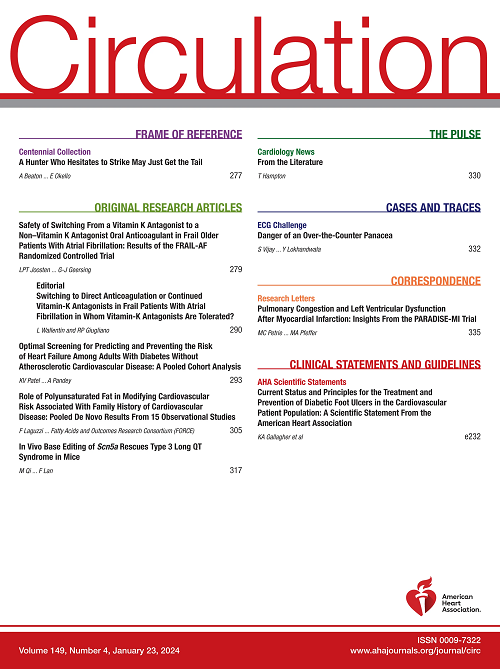Cellular Reprogramming by PHF7 Enhances Cardiac Function Following Myocardial Infarction.
IF 35.5
1区 医学
Q1 CARDIAC & CARDIOVASCULAR SYSTEMS
引用次数: 0
Abstract
BACKGROUND Direct reprogramming of fibroblasts to cardiomyocytes is a potentially curative strategy for ischemic heart disease. However, current reprogramming strategies require excessive factors due to epigenetic barriers of adult mouse and human fibroblasts. Recently, we identified the epigenetic factor PHF7 from a screen of gene-regulatory factors as the most potent activator of adult fibroblast-to-cardiomyocyte reprogramming in vitro. METHODS Through in vitro assays coupled with genome-wide studies, we interrogated the ability of PHF7 to induce reprogramming events with minimal reprogramming factors. Using in vivo murine models of myocardial infarction and intramyocardial reprogramming factor delivery coupled with genetic fibroblast lineage tracing, we delivered retroviral PHF7 cocktails to the murine heart and interrogated reprogramming events as well as the acute and chronic functional impact of these cocktails. Deployment of 10X multiomics in vivo generated a combinatorial single-nucleus transcriptomic and epigenomic atlas of PHF7 reprogramming in the infarcted heart. RESULTS Genome-wide in vitro transcriptomic analyses revealed that addition of PHF7 to Tbx5 or Mef2c and Tbx5 in fibroblasts induced global reprogramming through upregulation of unique cardiac transcriptomes. Further, PHF7 itself upregulated cardiac master regulators when overexpressed in dermal fibroblasts. Delivery of PHF7 cocktails to the infarcted murine heart induced in vivo reprogramming events and improved cardiac function and remodeling in both acute and chronic heart failure. When delivered as a single factor to the infarcted heart, PHF7 improved survival, function, and fibrosis up to 16 weeks after injury. Genetic lineage tracing analyses revealed that PHF7 induced bona fide fibroblast-to-cardiomyocyte reprogramming events in vivo. Comprehensive multiomics of PHF7 cocktails in the infarcted heart exposed the impact of PHF7 on chromatin structure, generating population-level shifts in nonmyocyte and cardiomyocyte cellular identity. CONCLUSIONS Here, we report the ability of a single epigenetic factor, PHF7, to induce reprogramming and improve cardiac function in the mouse heart following myocardial infarction. Together, these data support the premise that a single factor, when deployed into the infarcted mouse heart, can induce reprogramming events and recover function in the ischemic heart.心肌梗死后PHF7细胞重编程增强心功能
直接将成纤维细胞重编程为心肌细胞是缺血性心脏病的潜在治疗策略。然而,由于成年小鼠和人类成纤维细胞的表观遗传障碍,目前的重编程策略需要过多的因素。最近,我们从基因调控因子筛选中发现表观遗传因子PHF7是体外成人成纤维细胞向心肌细胞重编程的最有效激活因子。方法:通过体外实验和全基因组研究,我们探究了PHF7以最小重编程因子诱导重编程事件的能力。利用体内小鼠心肌梗死模型和心肌内重编程因子传递结合遗传成纤维细胞谱系追踪,我们将逆转录病毒PHF7鸡尾酒传递到小鼠心脏,并询问重编程事件以及这些鸡尾酒的急性和慢性功能影响。在体内部署10X多组学,生成了梗死心脏中PHF7重编程的组合单核转录组学和表观基因组图谱。结果体外全基因组转录组学分析显示,在成纤维细胞中添加PHF7到Tbx5或Mef2c和Tbx5通过上调独特的心脏转录组诱导全局重编程。此外,当PHF7在真皮成纤维细胞中过表达时,它本身也上调了心脏主调控因子。将PHF7鸡尾酒递送至梗死小鼠心脏诱导体内重编程事件,改善急性和慢性心力衰竭的心功能和重塑。当将PHF7作为单一因子递送到梗死心脏时,损伤后16周内,PHF7可改善存活、功能和纤维化。遗传谱系追踪分析显示,PHF7在体内诱导了真正的成纤维细胞到心肌细胞的重编程事件。梗死心脏中PHF7鸡尾酒的综合多组学研究揭示了PHF7对染色质结构的影响,产生非肌细胞和心肌细胞身份的群体水平变化。在这里,我们报道了单个表观遗传因子PHF7诱导心肌梗死后小鼠心脏重编程和改善心功能的能力。总之,这些数据支持一个前提,即当一个单一的因素被部署到梗死小鼠心脏时,可以诱导重编程事件并恢复缺血心脏的功能。
本文章由计算机程序翻译,如有差异,请以英文原文为准。
求助全文
约1分钟内获得全文
求助全文
来源期刊

Circulation
医学-外周血管病
CiteScore
45.70
自引率
2.10%
发文量
1473
审稿时长
2 months
期刊介绍:
Circulation is a platform that publishes a diverse range of content related to cardiovascular health and disease. This includes original research manuscripts, review articles, and other contributions spanning observational studies, clinical trials, epidemiology, health services, outcomes studies, and advancements in basic and translational research. The journal serves as a vital resource for professionals and researchers in the field of cardiovascular health, providing a comprehensive platform for disseminating knowledge and fostering advancements in the understanding and management of cardiovascular issues.
 求助内容:
求助内容: 应助结果提醒方式:
应助结果提醒方式:


